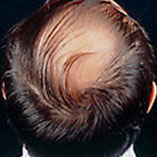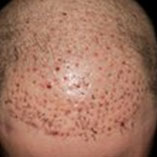Eyebrow hairtransplant
-

Loss of eyebrows
Unlike the loss of scalp hair, the loss of one’s eyebrows is not viewed as a natural process. Eyebrow hair may be lost for a variety of reasons, mostly health related, including thyroid and other systemic diseases, alopecia areata, infections, but also burns, tattoos, repeated plucking, congenital inability to grow eyebrows, a genetic tendency for eyebrows to thin with age.
-

Eyebrows transplant
The most important aspect of transplanting eyebrows is to follow the natural hair direction very closely. The recipient sites for the hairs must be made right along the surface of the skin at a very fine angle, to insure that the hair will lie along the surface of the skin as it grows. In order to recreate the "comet-like" aspect of the brow, the surgeon has to execute very subtle angle changes of the implants with a very fine-gauge needle.
An important particularity of eyebrow restoration is that only individual hair follicles can be used. But the donor area - the scalp - naturally grows 1 to 4-hair follicular units, so those must be divided up into 1-hair grafts using a stereo-microscope.
Also, hair follicles must be harvested from an area that matches the thickness of the eyebrows most closely:
- - if eyebrows hair is thick – harvest from mid-donor area of the scalp
- - if eyebrows are thin – harvest from the scalp behind the ear
-

After-transplant considerations
The hair transplanted to eyebrows will continue to grow and must therefore be periodically cut. This influences the final aspect of the brow in that trimming the hair does not leave a fine-tipped end of the natural hair. Over time the growth rate slows and trimming is less frequent.
An important particularity of eyebrow restoration is that only individual hair follicles can be used. But the donor area - the scalp - naturally grows 1 to 4-hair follicular units, so those must be divided up into 1-hair grafts using a stereo-microscope.
Ask more!
Ask a medical representative a question about hair transplant:
Latest news
-

Transplant procedures can be somewhat painful mainly due to local anesthesia using injections into the scalp. But new procedures do not involve needles
-

Hair transplantation can be performed at any age, technicaly, but probably in many cases doctors recommend patients to wait up to an age close to 30 years.
-

-

Depending on the method used for harvesting grafts, recovery time can vary from a few days (FUE method) to 1-2 weeks (FUT or STRIP method)
-

Very important rules for a healty transition after hair transplant surgery.
-

What technique? FUE or STRIP? Advantages and disadvantages of each.
Latest forum posts
-


In the forums section you can receive informed answers (including from a medical representative) about hairtransplant issues, products or services of interest to you. Just ask!

